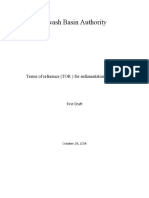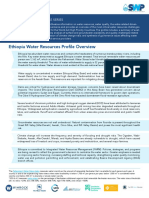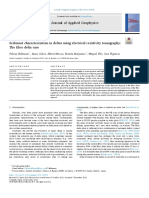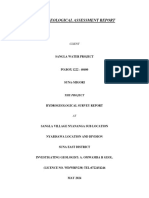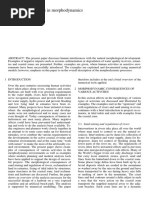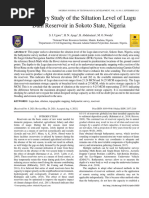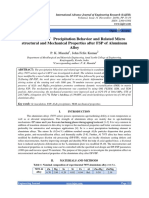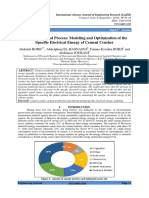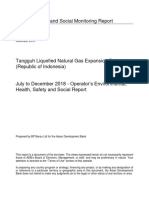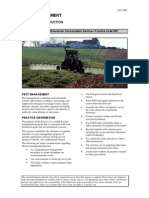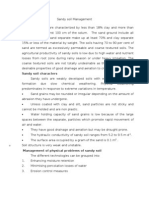Evaluation of Water Over Flowing Risk of Oryx Lake in Dakar, Senegal
Evaluation of Water Over Flowing Risk of Oryx Lake in Dakar, Senegal
Uploaded by
iajerCopyright:
Available Formats
Evaluation of Water Over Flowing Risk of Oryx Lake in Dakar, Senegal
Evaluation of Water Over Flowing Risk of Oryx Lake in Dakar, Senegal
Uploaded by
iajerOriginal Title
Copyright
Available Formats
Share this document
Did you find this document useful?
Is this content inappropriate?
Copyright:
Available Formats
Evaluation of Water Over Flowing Risk of Oryx Lake in Dakar, Senegal
Evaluation of Water Over Flowing Risk of Oryx Lake in Dakar, Senegal
Uploaded by
iajerCopyright:
Available Formats
International Advance Journal of Engineering Research (IAJER)
Volume2, Issue 11 (November- 2019), PP 24-31
ISSN: 2360-819X
www.iajer.com
Research Paper Open Access
Evaluation of Water over Flowing Risk of Oryx Lake
In Dakar, Senegal
Saidou NDAO1,2, Papa BabacarDiop THIOUNE2,3, Ababacar Fall2,
El HadjiBamba DIAW2*
1
University of Thies, Faculty of Science and Technology, City MalickSy, BP 967, Thies, Senegal.
2
Laboratory of Sciences and Technology of Water and Environment (LaSTEE),
Polytechnic School of Thies BPA 10 Thies, Senegal.
3
University Alioune DIOP of Bambey, Higher Institute of Agricultural and Rural Training (ISFAR)
PO Box 54, Bambey, Senegal
*Corresponding author: El Hadji Bamba DIAW
ABSTRACT:- The oryxlake, was once a lake designed to recharge the groundwater in Dakar. But, nowadays,
because of anarchic and raging urbanizationit is confronted with serious modifications involving imbalance on
ecosystem and causing devastating floods. In that area, flooding becomes more and more catastrophic,
worrying for Senegal government. Progressive urbanization leads a waterproofing surfaces thus reducing the
infiltration of rainwater. This reduction has as a corollary increased amounts of runoff. The object of this
present article is, through numerical modeling, to assess the risk of flooding linked to the excesses of the waters
of the lake representing the outlet of the catchments areas of Grand Yoff, Castors and Front de Terre. To do
this, we used the software Storm Water Management Model (SWMM) to simulate dripping rainwater and make
forecasts to horizon 2025. The results show that in 2025, an amount of water estimated at 371 149 m3 could
overflow from the lake if a ten years return period for rainfall, like a Kiefer one, is recorded. This result shows
that accompaniment measures are necessary to prevent flooding.
Keywords -Urbanization, rain water, Overflowing risk, Oryx lake, Dakar
I. INTRODUCTION
The Senegal, with an area of 196,722 km2, is one of the smallest countries in the Sahel [1]. Dakar, its
capital, with an area of 550 km2, occupies more than a quarter of the national population which, in 2013, was
estimated at 12.88 million inhabitants [2]. This rapid demographic change is due, on the one hand, to a natural
growth rate of 3% per year [2] and, on the other hand, to very large migratory flows. Indeed, with the drought of
the 1970s, Dakar saw its populations increase considerably because of the deterioration of living conditions in
rural areas. The massive rural exodus caused by drought has precipitated the population growth and
development of the Senegalese capital. Seasonal labor migration then turned into a permanent rural exodus from
the 1980s [3], [4], [5], [6], [7].
This increase in the population is at the origin of a multiplication of spontaneous neighborhoods. In
fact, the scarcity of land used for housing has led to a rush to undeveloped land that is particularly favorable to
long stagnation of rainwater. This situation results in the anarchic occupation of the space, without any
consideration of the natural ways of circulation of rain water [8], [9]. Thus, the lowlands that normally
constitute areas of concentration of runoff or simply outcropping of the ground water, are fragmented and
occupied, without any prior arrangement. For long periods, the authorities allowed the populations to illegally
take possession of these areas, yet declared non aedificandi (not habitable) by the Master Plan of Sanitation
established in 1994. This phenomenon has become widespread everywhere in the periphery of Dakar. Indeed,
before 1964, the urban watersheds of Grand Yoff, Castors and Front de Terre that have Oryx lake as their outlet
were only small neighborhoods [10]. Over the years, they have experienced a disturbing rate of urbanization,
resulting in their waterproofing with as a corollary, an ever increasing development in the runoff coefficient of
these basins. Oryx lake, following rains recorded in August 2005, experienced an overflow that caused
significant damage in surrounding neighborhoods [11]. However, this lake, had once had the essential function
of serving as an infiltration zone for all the rainwater drained by the Grand Yoff, Front de Terre and Castors
Engineering Journal www.iajer.com Page | 24
Evaluation of Water over Flowing Risk of Oryx Lake In Dakar, Senegal
basins for the recharge of the aquifer. Today, it acts as a clipping basin for rainwater originating from these
watersheds (photo 1).
Photo 1: ORYX lake with one of its parts backfilled and intended for housing
With the urbanization, this area has experienced floods during the month of August 2005. Indeed, in
the week of 16 to 22 August 2005, a cumulative rain of about 188 mm, fell on Dakar and its surrounding areas,
resulting in the flooding of large areas, resulting in dysfunctions in urban mobility, particularly at the low points
of the Dakar motorway [12] see photo 2. To combat these floods, emergency solutions, consisting of pumping
water, were mostly adopted. Today, it is envisaged the application of sustainable solutions consisting of
structural networks for rainwater drainage as part of the ten-year flood control program.
Photo 2: Flooding of Dakar Highway in August 2005
II. METHODS AND MATERIALS
II.1. Presentation of the study area
Oryx lake, also known as the storm water catchment area, is the natural outlet of the Grand Yoff
(BVUGY) urban watersheds, the Front de Terre and Castors [12] (Fig. 1). These watersheds have housed the so-
called “bocager” of the district municipality of Grand Yoff. The latter was composed of euphorbia hedges. This
“bocager” was a real green space especially during the rainy season [12]. With urbanization, green spaces have
decreased, giving way to infrastructure and housing. The soils of watersheds belong to the series of sandy soils
called “diors” according to Maignien's classification [12]. These are permeable and allow the infiltration of
water [13].
Engineering Journal www.iajer.com Page | 25
Evaluation of Water over Flowing Risk of Oryx Lake In Dakar, Senegal
Drainage channels to
the Niayes
Drainage channels to
the Oryx Lakelac Oryx
versle
Pumping stations
Watersheds limit
Oryx Lake
Scale: 1/40 000
Figure 1: location of drainage basins drained by Oryx lake [11].
II.2. Data and material
In 2005, the ORYX lake had only a storage capacity of 80,000 m3 because of its gradual refilling by
people seeking housing [11]. However, its capacity was 300,000 m3 in 1990 [11]. With the rain event of August
2005, there was an excess volume that overflowed to cause flooding of the banks of the lake and riparian areas.
Table 1 gives the characteristics of the runoff generated by this rain.
Table 1: Characteristics of runoff generated by the rain event of August 2005
Volume Max flow
Watershed Area (ha)runoff water thickness (mm) runoff coefficient (%)
streamed (m3) (m3/s)
Front de terre 200 71.3 142,600 51 15.84
Grand Yoff 200 71.24 142,490 50 15.58
Oryx lake 8 132.16 10,573 94 0.99
Bank of Oryx lake 15 70.95 10,643 50 1
Castors 40 71.56 28,624 50 3.63
Total 463 72.34 334,930 51 37.04
For a lake capacity estimated at 80,000 m3, the data in Table 1 show an excess volume of 254, 930 m3
overflowing the lake. The flooded areas rise to 24 ha occupying the banks of the lake, part of the highway of
Dakar and the City "Belle vue" is a height of flood of 1.06 m.
The 2005 floods on the shores of ORYX lake and surrounding areas alerted the appropriate authorities who tried
to address it by undertaking its rehabilitation. The latter gave the lake in 2006 the characteristics mentioned in
Table 2.
Table 2: ORYX lake Characteristics in 2006
Perimeter 1,600 m
Area 8 ha
Capacity 170,000 m3
upper level of the basin 9.75 m
Level of the lowest point 7.49 m
To avoid potential overfilling during the winter of 2006, technical provisions were made. Thus a
pumping system, intended to evacuate excess water from the lake to the sea using a pump delivering 950 m3/h
with a pumping time of 9 hours per day, was put in place. However, despite these measures taken by the
authorities, the risks of overflowing lake water were real.
Engineering Journal www.iajer.com Page | 26
Evaluation of Water over Flowing Risk of Oryx Lake In Dakar, Senegal
Based on these data provided by the DGPRE [11], the results of its studies, we used the EPA SWMM
software to evaluate the ORYX lake overflow risks in the case of a decennial rainfall event (a rainfall likely to
fall on average once after all ten years). The input data required for the software is as follows: area in ha or
percentage of impervious surface area (Simp) of catchment area, catchment area, daily rainfall in mm and
average slope of catchment.
To estimate the volumes of water received in Oryx Lake, we need the surface areas of the watersheds
that supply the lake. For this, we used a satellite image extracted from "google earth", with a resolution of 1 m
(Fig. 1), provided by the DGPRE that used this structure for the delimitation of watersheds and the
determination of their areas.
Rainfall data, in daily time steps over the period 1971-2013 were provided by the National Agency of
Civil Aviation and Meteorology (ANACIM).
As part of the Dakar Drainage Master Plan [8] (SGI/CABINET MERLIN/EDE GROUP, 2012), project
rains of return period T=10 years have been defined. They are five (5) in number and are defined as follows:
• Four (4) short duration rains, elaborated according to the double-triangle method [8], characterized by their
intense durations: 15, 30, 60 and 120 minutes, over a total duration of 4 hours;
• A long rain, Kiefer type, lasting 24 hours.
Table 3 gives the rainfall height according to the type of rain.
Table 3: Height of DPP project rains
Types of rain 4 H-15 mn 4 H-30 mn 4 H-60 mn 4H-120 mn Kiefer Type
intense intense intense intense duration 24 H
duration duration duration duration
Height (mm) 101.94 102.03 102 102 129.8
For the simulations, to put ourselves in the most critical case, we used the Kiefer type rain.
The estimation of the volumes that have elapsed also requires the determination of the runoff
coefficients of the watersheds. To do this, we used the EPA Storm Water Management Model software
(SWMM) which uses hydrological models such as Horton, Green Ampt, Curve Number [14]. It is a simplified
model of hydrological and hydraulic simulations used for hydrodynamic modeling study of the quantity of
runoff water on urban and rural watersheds in the case of a short or long-term rain event.
EPA SWMM input data provides the maximum daily flows, water slides, and runoff coefficient for each studied
watershed.
The runoff model used by EPA SWMM is a conceptual model [15], [16], [17], [18]. Its 1971 version
produced by US Environmental Protection Agency Dresser Camp & McKee Engineering Inc. represents the
watershed as a rectangular channel with free surface (Figure 2)
Figure 2: Schematic diagram of the runoff model by EPA SWMM
Engineering Journal www.iajer.com Page | 27
Evaluation of Water over Flowing Risk of Oryx Lake In Dakar, Senegal
The inflow Qe(t) corresponds to the excess precipitation (precipitation-infiltration-evaporation-interception by
vegetation or depressions at the surface of the catchment).
The outflow Qs(t) is calculated at each time step using the Manning-Strickler formula based on the channel
characteristics (width and roughness) and the height h(t) of the water slide that flows in. the canal.
(1)
In which and
Finally, a conservation equation of water volume (or storage law) connects at each time step, the water level h(t)
which flows, at inflows Qe(t) and outgoing Qs(t) equation
(2)
In which V(t) is the volume of the channel.
This model is part of nonlinear reservoir models. The impervious areas required for EPA SWMM modeling are
determined on the basis of interpolations, based on data provided by DIA’s method [19].
III. RESULTS AND DISCUSSIONS
III.1. Assessment of flood risk by overflow of Oryx Lake
The results of the EPA SWMM model (Table 4) show that a Kiefer-type decadal rainfall
could cause flooding in 2006.
Table 4: Runoff characteristics for a decadal rainfall in 2006
Watershed Area (ha) runoff water Volume runoff coefficient (%) Max flow
thickness (mm) streamed (m3) (m3/s)
Front de terre 200 77.34 154,680 54.8 16.78
Grand Yoff 200 77.31 154,620 54.7 16.50
Oryx lake 8 130.88 10,470 92.7 0.98
Bank of Oryx lake 15 76.98 11,547 54.5 1.05
Castors 40 77.66 30,850 54.6 3.84
Total 463 78.27 362,167 55.4 39.18
3
Indeed, for a ten-year Kiefer rain event, a quantity of 362,167 m could access the lake for a storage capacity of
170,000 m3. In this case, the populations of the banks of ORYX lake would be exposed to 183,617 m 3 which
would have overflowed corresponding to a height of flood of 0.77 m for a flooded surface of 24 ha. In 2006,
such a rain event was certainly not noted but the lake has often threatened to overflow following simple rains.
This did not fail to alert the authorities about the lake's low storage capacity. Consequently, the State has
undertaken work to increase the storage capacity to prevent overflow risks during the winter of 2007. This work
involved the construction of a 1.20 m storage capacity from 170,000 m3 to 266,000 m3. In addition, a new pump
delivering 1 m3/s has been installed. Table 5 gives the characteristics of runoff that would have been generated
by a Kiefer-type 10-year rainfall event in 2007 according to EPA SWMM forecasts.
Table 5: Runoff Characteristics for Kiefer Decadal Rainfall in 2007
Watershed Area (ha) runoff water Volume runoff coefficient (%) Max flow
thickness (mm) streamed (m3) (m3/s)
Front de terre 200 83.35 166,700 59 17.70
Grand Yoff 200 83.33 166,660 59 17.41
Oryx lake 8 132.26 10,581 93.6 0.93
Bank of Oryx lake 15 82.96 12,444 58.7 1.11
Castors 40 83.70 33,480 59.3 4.08
Total 463 84.20 389 865 59.6 41.29
The EPA SWMM forecast shows that there would be a surplus of 149,465 m 3 which would overflow,
taking into account the volume of 58 000 m3 occupied by the wastewater generated by the illegal connections.
This corresponds to a flooded area of 22 ha for a flood height of 0.68 m. Indeed, knowing that Grand Yoff has a
population estimated at 100,000 inhabitants and that 60% of the population is legally connected to the
wastewater drainage network. National Office of Sanitation of Senegal (ONAS), an average monthly volume of
18,250 m3 of wastewater would be discharged into the lake (It is assumed that 25% of the population is
clandestinely connected to the rainwater network for 20 l/day/hbt spilled on average in the lake). For an annual
Engineering Journal www.iajer.com Page | 28
Evaluation of Water over Flowing Risk of Oryx Lake In Dakar, Senegal
evaporation of 1.1 m, a volume equivalent of 120,000 m 3, the quantity of wastewater available in the lake could
reach 58 000 m3 at the beginning of the rainy season (Photo 3).
Photo 3: ORYX lake flooded with sewage due to illegal connections
This means that the drainage plan, despite the changes made between 2005 and 200, still had limits that
would have the main consequences of the floods that would occur in the case of a decennial rainfall event.
The maximum daily rainfall (10 years) is considered to be 142 mm (corresponding to the adjusted
value of the last decennial rainfall observed in Dakar in 2005). Knowing the duration of the rain, assumed to be
equal to 7 hours, the runoff coefficient and the total volume of run-off water per hour on the catchments
concerned, the volume stored by the lake is calculated after pumping. The expected results (Table 6) show that
the existing network has limitations with respect to the lake's storage capacity of all runoff volume.
Table 6: Simulation of the behavior of the Oryx lake in 2007 in the case of a Kiefer-type decadal rain
event
Duration Precipitations Collected Volume Pumped Volume Stored Volume
(hour) (mm) (m3) (m3) (m3)
initial Volume 58,000
1st hour 26 69,817 3,600 124,217
2nd hour 10 26,853 3,600 147,470
3rd hour 13 34,908 3,600 178,778
4th hour 23 61,761 3,600 236,939
5th hour 34 91,299 3,600 324,638
6th hour 12 32,223 3,600 353,261
7th hour 24 64,446 3,600 414,107
8th hour 0 0 3,600 410,507
9th hour 0 0 3,600 406,907
Rainfall similar to that of 2005, that is to say, a decennial type of rain could still cause overflows at the ORYX
lake which would amount to 140,907 m3 corresponding to a floodable surface of 22 ha, ie a height of flood of
0.64 m.
Therefore, we propose that a new network be sized considering the forecasts by 2025.
III.2. Proposal for a new stormwater drainage plan
In the drainage network that we will propose, we will consider the characteristics of watersheds by
2025 in order to make a dimensioning whose results will allow the realization of networks that will function
efficiently and sustainably.
In what follows, we will resize the drainage network by considering the values that could take the coefficient of
runoff at this horizon. Indeed, if nothing is done to stop the rate of urbanization in the study area, the runoff
coefficient could reach 93% in 2025. The results mentioned in Table 7 are provided by EPA SWMM to the
horizon 2025.
Engineering Journal www.iajer.com Page | 29
Evaluation of Water over Flowing Risk of Oryx Lake In Dakar, Senegal
Table 7: Characteristics of runoff that would be generated by a decadal rainfall in 2025
Watershed Area (ha) runoff water Volume runoff coefficient (%) Max flow
thickness (mm) streamed (m3) (m3/s)
Front de terre 200 131.29 262,580 93 24.38
Grand Yoff 200 131.23 262,460 93 23.96
Oryx lake 8 132.26 10,581 93.6 0.99
Bank of Oryx lake 15 130.57 19,586 92.4 1.52
Castors 40 131.84 52,736 93.3 5.68
Total 463 131.31 607, 943 93 56.54
A problem of space arises at the level of ORYX lake to collect all the waters emanating from the
watersheds of Grand Yoff, Castors and Front de Terre. In fact, the cumulative incoming volume estimated at
607,943 m3 is greater than the estimated outgoing volume of 32,400 m 3 according to the performance of the
planned pump delivering 1 m3/s for a duration of 9 hours corresponding to the sum of the duration of the
downpour and the concentration time of runoff from decadal rainfall. And since the storage capacity of the
infiltration basin amounts to 266,000 m3 and the quantity of sewage discharged illegally is estimated at 58,000
m3, the excess volume to be evacuated would be 371,149 m3 (Table 8) which corresponds to a flooded area of
24 ha for a flood height of 1.55 m: an alarming case.
Table 8: Simulation of the quantities of water likely to cause floods following a Kiefer-type decadal
rainfall event in 2025 with a pumping rate of 1 m3/s
Duration (hour) Precipitations Collected Volume Pumped Volume Stored Volume
(mm) (m3) (m3) (m3)
Initial stock 58,000
1st hour 26 111,974 3,600 166,374
2nd hour 10 43,067 3,600 205,841
3rd hour 13 55,987 3,600 258,228
4th hour 23 99,054 3,600 353,682
5th hour 34 146,427 3,600 496,509
6th hour 12 51,680 3,600 544,589
7th hour 24 103,360 3,600 644,349
8th hour 0 0 3,600 640,749
9th hour 0 0 3,600 637,149
Knowing that the expected pumping rate, amounting to 1 m 3/s, is low, it will be necessary to set up a more
efficient pumping system that can deliver up to 10 m3/s to relieve the neighboring populations of possible
overflows of the waters of ORYX lake. In this case, Table 9 gives the results of the simulation done for the
verification of the quantities of water likely to cause floods by 2025.
Table 9: Simulation of quantities of water likely to cause floods following a decennial rainfall event in
2025 with a pumping rate of 15 m3/s
Duration (h) Precipitations (mm) Collected Volume Pumped Volume Stored Volume
(m3) (m3) (m3)
Initial stock 58,000
1st h 26 111,974 54,000 115,974
2nd h 10 43,067 54,000 105,041
3rd h 13 55,987 54,000 107,028
4th h 23 99,054 54,000 152,082
5th h 34 146,427 54,000 244,509
6th h 12 51,680 54, 000 242,189
7th h 24 103,360 54, 000 291,549
8th h 0 0 54, 000 237,549
9th h 0 0 54, 000 183,549
The results in Table 9 show that a pump station discharging 15 m3/s would avoid overflows since the volumes to
be stored would be bearable at any time by the lake with a capacity of 266,000 m3, in this case.
Engineering Journal www.iajer.com Page | 30
Evaluation of Water over Flowing Risk of Oryx Lake In Dakar, Senegal
IV. CONCLUSION
From this study, it is clear that the floods have become a real problem for the populations of Grand
YOFF, the residents of ORYX lake and for the competent authorities. But while it is true that sanitation has long
been treated as a poor relation, today, not to mention since the floods of 2005, the state seems to be making it
one of its development priorities, according to the significant resources allocated to this sector. However, it is
not enough to put means to get Dakar out of the waters in which it bathes almost during the entire duration of
each rainy season and even during a large part of the dry season. This means that concerted management of the
flood problem has become more than an urgency to harmonize the interventions and reinforce the synergy
between the different State structures that are concerned, as well as those of the local communities.
This article will, we hope, provide additional elements of response on the influence of urbanization,
which is evolving exponentially, on the floods in Dakar particularly at the level of watersheds with outlet
ORYX lake. The study of the evolution of the runoff coefficient according to that of the increasing urbanization
made it possible to specify the potential contribution of this one on the waterproofing of the catchment and in
fact on the floods in the area of the Niayes.
Oryx lake is to be watched because of the risks of overflowing due to an exceptional rain event. To
prevent these risks, it will be essential to ensure that the evacuation capacity of the pumping station is always
greater than the volume of water emanating from the watersheds discharging their runoff into the lake.
This preventive measure of risk is to be taken seriously by the administrative authorities of Senegal all
the more as with the progressive urbanization, the Oryx lake is already in state of alert. This situation combined
with the effects of climate change that could increase the amount of rainwater, leaves a risk more than ever
alarming.
REFERENCES
[1]. DPS, 2008. Study report on urbanization in Senegal.
[2]. ANSD, 2013. Results on the census of the population of Senegal.
[3]. NDAO, M.2012. Dynamics and environmental management from 1970 to 2010 of wetlands in Senegal:
study of land use by remote sensing Niayes with DjiddahThiaroye Kao (Dakar), Mboro (Thies) and St.
Louis, PhD thesis. UGB, St. Louis.370p.
[4]. BASSEL. M., 1996. Water and the environment in Dakar: rain, runoff, pollution and drainage:
contribution to the study of water-related environmental problems in the Dakar region. Doctoral Thesis,
Department of Geography, UCAD, 258P.
[5]. BOUVIER. C., 1990. Contribution to the study of urban runoff in West Africa. Ph.D. thesis, University
of Montpellier 2, 311p.
[6]. DACOSTA S., 2009: Dakar and Sahel Floods: Sustainable Rainwater Management, Dakar, Enda
Editions, 265 p.
[7]. MOREL. A., 1996.Sunday Water Sanitation in Sub-Saharan Urban Environment. 167p.
[8]. SGI / CABINET MERLIN / EDE GROUP, Study of the Drainage Master Plan (DDP) for rainwater in
the peri-urban region of Dakar, Final Study Report, Municipal Development Agency (ADM), Dakar,
320 pages, 2012.
[9]. JICA, 1994. Study on the Sanitation of Dakar and its surroundings. Main report, 283p.
[10]. DIAGNE. K., 1993. The problem of sanitation in Dakar neighborhoods: example of Grand Yoff.
Master's thesis, UCAD, 109p.
[11]. DGPRE, 2005. Report of the Technical Commission for the Implementation of the "Jaxaay" Plan.
Dakar, 16p.
[12]. Maignien.R., 1959. Soils of the peninsula of Cape Verde.ORSTOM. Pedological map at 1/50000th,
163p.
[13]. SENE.O., (2000). Yoff's Urban Watershed: Flows and Environmental Problems, 98p.
[14]. EPA SWMM Version 1971 produced by US Environmental Protection Agency Camp Dresser &
McKee Engineering Inc.
[15]. McCuen, R. et al. (1996), Hydrology, FHWA-SA-96-067, Federal Highway Administration,
Washington, DC
[16]. Perrin, C. (2000). Towards global rain-flow model improvement through a comparative approach. PhD
thesis, INPG (Grenoble) / CEMAGREF (Anthony), France, 530 p.
[17]. AMANI. A., 2006. Course notes Hydrological Modeling. CRA, Niamey.
[18]. Mouelhi, S., 2003. Towards a coherent chain of global conceptual models with rain-flowing at several
time steps, annual, monthly and daily.Thesis, ENGREF, CEMAGREF Anthony, France, 323 pp.
[19]. DIA I.K. 2004. Impacts of Urbanization on Stormwater Drainage in the Urban YOFF Watershed.
Thesis, Gaston Berger University, Saint Louis, 148 p.
Engineering Journal www.iajer.com Page | 31
You might also like
- ToR For Sedimentation Modeling 1st DraftDocument34 pagesToR For Sedimentation Modeling 1st DraftABITI GETANEH GEBREMESKELNo ratings yet
- Ama2005 1Document98 pagesAma2005 1Associate Professor Dr. Said Elshahat AbdallahNo ratings yet
- ++++ImpactDamConstruction COGELSal 1997 PDFDocument16 pages++++ImpactDamConstruction COGELSal 1997 PDFBARRY AlsenyNo ratings yet
- SAS - Notes Unit 4 J Unit 5Document12 pagesSAS - Notes Unit 4 J Unit 5polinaszeniawskiNo ratings yet
- AccraecoDocument9 pagesAccraecoapi-236125865No ratings yet
- Ethiopia Water Resources Profile OverviewDocument11 pagesEthiopia Water Resources Profile Overviewbantalem100% (1)
- Earth Surf Processes Landf - 2005 - Vericat - Sediment Transport in A Highly Regulated Fluvial System During TwoDocument18 pagesEarth Surf Processes Landf - 2005 - Vericat - Sediment Transport in A Highly Regulated Fluvial System During TwotsotopNo ratings yet
- 10 11648 J Cse 20200402 11Document16 pages10 11648 J Cse 20200402 11ebagalan2022No ratings yet
- S.19.07.Modeling Hydrologic Regime of A Terminal Lake Basin With GCM Downscaled Scenarios - YEO HOWE LIMDocument8 pagesS.19.07.Modeling Hydrologic Regime of A Terminal Lake Basin With GCM Downscaled Scenarios - YEO HOWE LIMSiharath PhoummixayNo ratings yet
- Particulate Ow at The Mouth of The Soummam Watershed (Algeria)Document9 pagesParticulate Ow at The Mouth of The Soummam Watershed (Algeria)bougheraraNo ratings yet
- 3-Journal - IMPACT OF GROUNDWATER EXPLOITATION ON SALTWATER INTRUSION IN COASTAL AQUIFERDocument12 pages3-Journal - IMPACT OF GROUNDWATER EXPLOITATION ON SALTWATER INTRUSION IN COASTAL AQUIFERMona HagrasNo ratings yet
- Water ModuleDocument64 pagesWater ModuleTaleb AbboudNo ratings yet
- dw2018 Paper ArboletalDocument11 pagesdw2018 Paper ArboletalBrandon Jara PizarroNo ratings yet
- IntroductionDocument19 pagesIntroductionabonga petseNo ratings yet
- Sunken Kingdom of ANGKORDocument6 pagesSunken Kingdom of ANGKORUday DokrasNo ratings yet
- (2003) Wels C. & Robertson A. MacG. - Conceptual Model For Estimating Water Recovery in Tailings Impoundments PDFDocument8 pages(2003) Wels C. & Robertson A. MacG. - Conceptual Model For Estimating Water Recovery in Tailings Impoundments PDFLuis Miguel La TorreNo ratings yet
- Hydro GeologyDocument20 pagesHydro Geologymilk ramsNo ratings yet
- TYROLEAN WEIR INTAKES PERUDocument10 pagesTYROLEAN WEIR INTAKES PERUasappasalimNo ratings yet
- Modelling of Rainfall-Runoff RelationshipDocument13 pagesModelling of Rainfall-Runoff RelationshipRas MekonnenNo ratings yet
- High Dam PDFDocument14 pagesHigh Dam PDFDr-Moamen Abd El RaoufNo ratings yet
- Sub 152103Document9 pagesSub 152103Joko LumawagNo ratings yet
- Royal Society Philosophical Transactions: Mathematical, Physical and Engineering SciencesDocument31 pagesRoyal Society Philosophical Transactions: Mathematical, Physical and Engineering SciencesJnr FiavaaiNo ratings yet
- Institute of Graduate Studies: Romblon State University Odiongan, RomblonDocument4 pagesInstitute of Graduate Studies: Romblon State University Odiongan, RomblonStevenzel Eala EstellaNo ratings yet
- Page 1 of 8: Water Resources EngineeringDocument8 pagesPage 1 of 8: Water Resources EngineeringYousiff AliNo ratings yet
- Mulugeta's ArticleDocument5 pagesMulugeta's Articlemulugetaazeze94No ratings yet
- Conceptualization of Hydraulic and Sedimentary Processes in Downstream Reaches During Flushing of ReservoirsDocument12 pagesConceptualization of Hydraulic and Sedimentary Processes in Downstream Reaches During Flushing of Reservoirsmdelaneze2No ratings yet
- 1 - 3 (1 - 6 - 1) Hydrology-Hydrogeology - FinalDocument34 pages1 - 3 (1 - 6 - 1) Hydrology-Hydrogeology - FinaldfaloutsosNo ratings yet
- Sediment Characterization in Deltas Using Electrical Resistivity Tomography - The Ebro Delta Case - Parte1Document4 pagesSediment Characterization in Deltas Using Electrical Resistivity Tomography - The Ebro Delta Case - Parte1andreinaNo ratings yet
- WaterDocument23 pagesWaterfurahastoresNo ratings yet
- Water Engineering IiDocument110 pagesWater Engineering IiAhmed AnsariNo ratings yet
- ManzalaDocument18 pagesManzalaKhaled NaguibNo ratings yet
- Quantifying Rooftop Rainwater Harvest PoDocument3 pagesQuantifying Rooftop Rainwater Harvest PoTilahun TegegneNo ratings yet
- 11 Sedimentacion en Embalses (Ingles)Document8 pages11 Sedimentacion en Embalses (Ingles)Luis AzulaNo ratings yet
- Water Storage Dam in The Tempisque Basin: Scoping For Environmental Impact Assessment (EIA)Document14 pagesWater Storage Dam in The Tempisque Basin: Scoping For Environmental Impact Assessment (EIA)AndiansyahNo ratings yet
- Final - Paper - Submitted To - NCSTI-revisedDocument6 pagesFinal - Paper - Submitted To - NCSTI-revisedmulugetaazeze94No ratings yet
- 1-1 Hydrologic CycleDocument40 pages1-1 Hydrologic CycleNuman ShahNo ratings yet
- Project Report On: Feasibility Site Selection For Barrage Construction Lake Zeway Outflow RegulationDocument30 pagesProject Report On: Feasibility Site Selection For Barrage Construction Lake Zeway Outflow Regulationmame MagnawNo ratings yet
- Overview of River Over Drainage Channels in The Wailela River Watershed, Teluk Ambon District, Ambon CityDocument19 pagesOverview of River Over Drainage Channels in The Wailela River Watershed, Teluk Ambon District, Ambon CityIJAERS JOURNALNo ratings yet
- 1A - Hydrologic Cycle - READY - FINAL - 2019-2020 - FINALDocument40 pages1A - Hydrologic Cycle - READY - FINAL - 2019-2020 - FINALDanNo ratings yet
- The Hydrological Functioning of The Watershed of Lake Laya - El Hammam, East of TunisiaDocument5 pagesThe Hydrological Functioning of The Watershed of Lake Laya - El Hammam, East of TunisiaInternational Journal of Innovation Engineering and Science ResearchNo ratings yet
- Chapter 4-Reservoir SedimentationDocument9 pagesChapter 4-Reservoir SedimentationselahNo ratings yet
- Human Interferences in MorphodynamicsDocument12 pagesHuman Interferences in MorphodynamicsAhmad BalahNo ratings yet
- Introduction & Water BalanceDocument50 pagesIntroduction & Water BalanceMUHAMMAD ILHAM ADZIM HAZMANNo ratings yet
- How To Write ProposalDocument25 pagesHow To Write ProposalsolomonNo ratings yet
- Hydrologic CycleDocument42 pagesHydrologic CycleMr EngineerNo ratings yet
- Introduction To Surface Water Hydrology: Philip B. Bedient Rice University 2006Document53 pagesIntroduction To Surface Water Hydrology: Philip B. Bedient Rice University 2006Abdelkader Faklani DouNo ratings yet
- Investigation of Siltation in Dumaguil River: Oertitle PageDocument18 pagesInvestigation of Siltation in Dumaguil River: Oertitle PageYusuf GeronaNo ratings yet
- 140water Crisis IsraelDocument11 pages140water Crisis Israelnasser_eNo ratings yet
- River Weirs - Good Practice Guide Guide - Section B2: Charles Rickard, Rodney Day, Jeremy PursegloveDocument35 pagesRiver Weirs - Good Practice Guide Guide - Section B2: Charles Rickard, Rodney Day, Jeremy Pursegloveeduardotorri100% (1)
- Ajol File Journals - 538 - Articles - 216977 - Submission - Proof - 216977 6337 534188 1 10 20211105Document6 pagesAjol File Journals - 538 - Articles - 216977 - Submission - Proof - 216977 6337 534188 1 10 20211105ahmadNo ratings yet
- 1 - Hydrology and Irrigation EnggDocument40 pages1 - Hydrology and Irrigation EnggKesav kNo ratings yet
- Study and Design of Mini Dam On Adan River Near Bori Gosavi VillageDocument9 pagesStudy and Design of Mini Dam On Adan River Near Bori Gosavi VillageVishal NagpureNo ratings yet
- Barcelona SWRODocument18 pagesBarcelona SWROHouria Azizi AlaouiNo ratings yet
- Hurley Et Al 2018 Microplastic Contamination River Beds NatureDocument11 pagesHurley Et Al 2018 Microplastic Contamination River Beds Naturerodrigo gtzNo ratings yet
- Ground Water Level in Dhaka CityDocument16 pagesGround Water Level in Dhaka Citymasud jipuNo ratings yet
- Decommisioning DamsDocument6 pagesDecommisioning DamsDigvijay MaheshwariNo ratings yet
- The Physical Attributes of The Lake Naivasha CatchDocument14 pagesThe Physical Attributes of The Lake Naivasha Catchdiode kenyaNo ratings yet
- Wabi Shebele River BasinDocument16 pagesWabi Shebele River BasinZOMA TUBE100% (3)
- Okavango Delta - WikipediaDocument57 pagesOkavango Delta - WikipedianyielkhannyelNo ratings yet
- Journal of African Earth Sciences: Sherif Ahmed Abu El-Magd, T.H. Taha, H.H. Pienaar, P. Breil, R.A. Amer, PH NamourDocument12 pagesJournal of African Earth Sciences: Sherif Ahmed Abu El-Magd, T.H. Taha, H.H. Pienaar, P. Breil, R.A. Amer, PH NamourRifaiNo ratings yet
- Fanack Water Files: Water Challenges and Solutions in Jordan, with a Special Report on the Red Sea–Dead Sea ProjectFrom EverandFanack Water Files: Water Challenges and Solutions in Jordan, with a Special Report on the Red Sea–Dead Sea ProjectNo ratings yet
- The Negligence Aspects of Project Risk Management (PRM) : Walaa Saleh Alzahrani Mashael Mahmoud KhayyatDocument5 pagesThe Negligence Aspects of Project Risk Management (PRM) : Walaa Saleh Alzahrani Mashael Mahmoud KhayyatiajerNo ratings yet
- Operation and Maintenance of HVAC System For Corona Virus: Samuel W ChungDocument16 pagesOperation and Maintenance of HVAC System For Corona Virus: Samuel W ChungiajerNo ratings yet
- Negative Pressure OF HVAC System For Corona Virus: Samuel W ChungDocument15 pagesNegative Pressure OF HVAC System For Corona Virus: Samuel W ChungiajerNo ratings yet
- Novel Approach On Audio To Text Sentiment Analysis On Product ReviewsDocument8 pagesNovel Approach On Audio To Text Sentiment Analysis On Product ReviewsiajerNo ratings yet
- Image Identification Using CMOS-Memristor Hybrid Architecture in Neuromorphic SystemDocument7 pagesImage Identification Using CMOS-Memristor Hybrid Architecture in Neuromorphic SystemiajerNo ratings yet
- Antropocene Fear of Nature: Pro. Jan-Erik LaneDocument3 pagesAntropocene Fear of Nature: Pro. Jan-Erik LaneiajerNo ratings yet
- Object Detection Techniques For Mobile Robot Navigation in Dynamic Indoor Environment: A ReviewDocument11 pagesObject Detection Techniques For Mobile Robot Navigation in Dynamic Indoor Environment: A ReviewiajerNo ratings yet
- A State-of-Art Review On The Interfacial Bond Strength of Bituminous Overlay in Asphalt PavementsDocument7 pagesA State-of-Art Review On The Interfacial Bond Strength of Bituminous Overlay in Asphalt PavementsiajerNo ratings yet
- Growth Regulators Functions in Horticultural Crops: Eknaik, V S S V PrasannaDocument6 pagesGrowth Regulators Functions in Horticultural Crops: Eknaik, V S S V PrasannaiajerNo ratings yet
- Solution of Heat and Wave Equations Using Mahgoub Adomian Decomposition MethodDocument5 pagesSolution of Heat and Wave Equations Using Mahgoub Adomian Decomposition MethodiajerNo ratings yet
- Hydrochemical and Statistical Characterization of Basement Aquifer Groundwater in The Extreme Northern TogoDocument19 pagesHydrochemical and Statistical Characterization of Basement Aquifer Groundwater in The Extreme Northern TogoiajerNo ratings yet
- Face Detection and Recognition System: Mr. Tilak Pandya, Mr. Praveen Chauhan, Ms. Viplavi PanchalDocument8 pagesFace Detection and Recognition System: Mr. Tilak Pandya, Mr. Praveen Chauhan, Ms. Viplavi PanchaliajerNo ratings yet
- Performance of A Current-Fed Soft Switched Full-Bridge Boost Double Stage Converter Using ZVS PWMDocument8 pagesPerformance of A Current-Fed Soft Switched Full-Bridge Boost Double Stage Converter Using ZVS PWMiajerNo ratings yet
- A New Constant From Classical Nucleation Theory: John H. JenningsDocument6 pagesA New Constant From Classical Nucleation Theory: John H. JenningsiajerNo ratings yet
- A Mathematical Evaluation of HVAC Energy Recovery: Samuel W Chung, Jeong Je JoDocument4 pagesA Mathematical Evaluation of HVAC Energy Recovery: Samuel W Chung, Jeong Je JoiajerNo ratings yet
- Investigation of Precipitation Behavior and Related Micro Structural and Mechanical Properties After FSP of Aluminum AlloyDocument5 pagesInvestigation of Precipitation Behavior and Related Micro Structural and Mechanical Properties After FSP of Aluminum AlloyiajerNo ratings yet
- Cement Industrial Process: Modeling and Optimization of The Specific Electrical Energy of Cement CrusherDocument10 pagesCement Industrial Process: Modeling and Optimization of The Specific Electrical Energy of Cement CrusheriajerNo ratings yet
- Improvements of Pegasis Routing Protocol in WSN: Aya Ayad Hussein, Rajaaaldeenabd KhalidDocument14 pagesImprovements of Pegasis Routing Protocol in WSN: Aya Ayad Hussein, Rajaaaldeenabd KhalidiajerNo ratings yet
- Antioxidant Capacity of Some Turkish Pomegranate Genotypes Grown in Siirt RegionDocument6 pagesAntioxidant Capacity of Some Turkish Pomegranate Genotypes Grown in Siirt RegioniajerNo ratings yet
- Text Mining Assistant: Muslum Serdar Akis, Semih UtkuDocument6 pagesText Mining Assistant: Muslum Serdar Akis, Semih UtkuiajerNo ratings yet
- EpicModelDocumentation PDFDocument377 pagesEpicModelDocumentation PDFTaku MuranduNo ratings yet
- Crop Production GuidelinesDocument23 pagesCrop Production GuidelinesyaredNo ratings yet
- 001 Esmr en - 2Document202 pages001 Esmr en - 2arditais04No ratings yet
- Topic 1: Central Luzon State UniversityDocument29 pagesTopic 1: Central Luzon State UniversityZACK PHILIP AQUINONo ratings yet
- Environmental StudiesDocument120 pagesEnvironmental StudiesrameshNo ratings yet
- Minnesota Shoreland Homeowner's Guide To Lake Stewardship - Cass CountyDocument24 pagesMinnesota Shoreland Homeowner's Guide To Lake Stewardship - Cass CountyFree Rain Garden ManualsNo ratings yet
- Leed Green Associate Made Easy EbookDocument92 pagesLeed Green Associate Made Easy EbookHVACDESIGNNo ratings yet
- Lecture31 STORM WATER MANAGEMENT PDFDocument38 pagesLecture31 STORM WATER MANAGEMENT PDFHoney Grace TizonNo ratings yet
- Water Pollution Impacts On Livelihoods: A Case Study of Fishing Communities in Tungabhadra Sub BasinDocument20 pagesWater Pollution Impacts On Livelihoods: A Case Study of Fishing Communities in Tungabhadra Sub BasinRitik KanoujiaNo ratings yet
- Pollution and Smog: Group 3 ReportingDocument20 pagesPollution and Smog: Group 3 ReportingCharlene LabillesNo ratings yet
- Project On Watershed ManagementDocument59 pagesProject On Watershed Managementsaurabhd70100% (2)
- 2010 MARC Sediment Pollution PamphletDocument2 pages2010 MARC Sediment Pollution PamphletMartha LetchingerNo ratings yet
- Water Retention LandscapeDocument6 pagesWater Retention Landscapemuhammad kamilNo ratings yet
- American Journal of Engineering Research (AJER)Document7 pagesAmerican Journal of Engineering Research (AJER)Jose MagalNo ratings yet
- USLE Application-1Document12 pagesUSLE Application-1roy4gaming.ytNo ratings yet
- Fundamental of IrrigationDocument109 pagesFundamental of Irrigation20CE015 Swanand DeoleNo ratings yet
- Ects Name:: Hydrology and Hydraulic Structures 9Document1 pageEcts Name:: Hydrology and Hydraulic Structures 9Astrit E. SalihuNo ratings yet
- Chapter - Viii Recommended Water Harvesting and Watershed Management WorksDocument7 pagesChapter - Viii Recommended Water Harvesting and Watershed Management Worksrams12380No ratings yet
- Pest Management 595 2008Document3 pagesPest Management 595 2008fernandoNo ratings yet
- Lecture Notes - Methods of Soil Survey. Feb.23Document12 pagesLecture Notes - Methods of Soil Survey. Feb.23arifurrahman3579No ratings yet
- Groundwater Assessment StudiesDocument2 pagesGroundwater Assessment Studiessumaiyah_fzNo ratings yet
- SCMD 2017Document728 pagesSCMD 2017Francisco Nguema ManeNo ratings yet
- HydrologyDocument7 pagesHydrologyashish upadhayaNo ratings yet
- EIA 1154kisima Park EIA Project Study Report PDFDocument86 pagesEIA 1154kisima Park EIA Project Study Report PDFEman ShaàbanNo ratings yet
- Chapter 4 Drainage DesignDocument47 pagesChapter 4 Drainage DesignhamzaNo ratings yet
- Reservoirs On The Mountain Rivers and Their Safety: SciencedirectDocument3 pagesReservoirs On The Mountain Rivers and Their Safety: SciencedirectFlorea RazvanNo ratings yet
- 1 CE 414 Hydrology IntroductionDocument34 pages1 CE 414 Hydrology IntroductionKhalid KhanNo ratings yet
- Sandy Soil ManagementDocument10 pagesSandy Soil ManagementAlex IsacNo ratings yet
- Emb Memorandum Circular: Environmental Management BureauDocument31 pagesEmb Memorandum Circular: Environmental Management BureauJing Jing100% (1)
